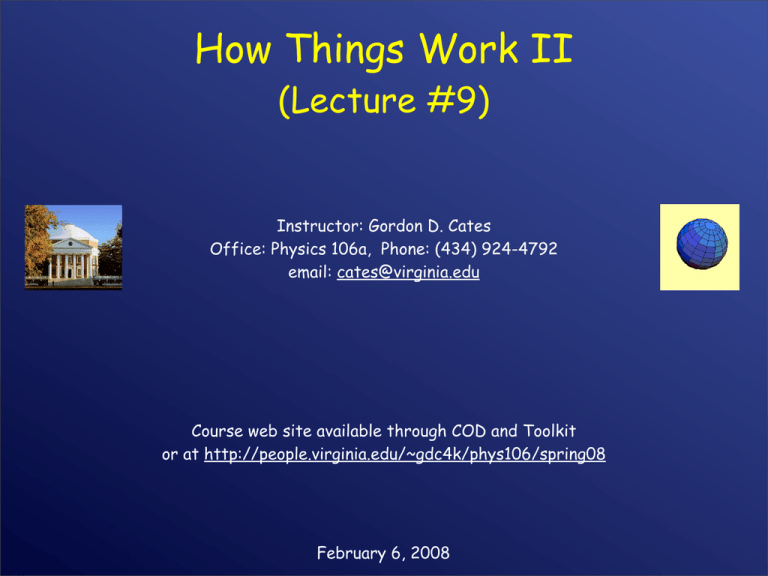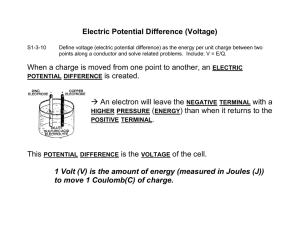Lecture 9.
advertisement

How Things Work II (Lecture #9) Instructor: Gordon D. Cates Office: Physics 106a, Phone: (434) 924-4792 email: cates@virginia.edu Course web site available through COD and Toolkit or at http://people.virginia.edu/~gdc4k/phys106/spring08 February 6, 2008 Announcements • Please read through section 10.2 by Friday. • I believe that the problem with the receipts from eclass is fixed. Is it? • There was an error on the due date, it is now fixed, and I don’t believe that anyone will be inappropriately penalized. Electric Charge 1 • • • Two types: positive and negative. Like charges repel, opposites attract. - Forces consist of a matched pair: • • Each charge pushes or pulls on the other. Forces have equal magnitudes, opposite directions. Forces increase with decreasing separation. Charge is measured in coulombs. Electric Charge 2 • • • Charge is conserved. Charge is quantized. - One fundamental charge is 1.6·10-19 coulombs Charge is an intrinsic property of matter. - Electrons are negatively charged. Protons are positively charged. Each has one fundamental charge (of opposite sign). Net Charge • • • Net charge is the sum of an object’s charges. Most objects have zero net charge (they are neutral). Neutral objects contain equal amounts of + and - charges. Charging objects by rubbing them together • • Rubbing a teflon rod with silk leaves a negative charge on the teflon. Rubbing a plexiglas rod with teflon leaves a positive charge on the plexiglas. Question: A woman rubs her feet on the carpet and gives a shock to her identical twin. If the twin also rubs her feet on the carpet before being touched, the shock will be: A. larger. B. smaller. C. the same size. Coulomb’s Law • The force between two charged particles is given by Coulomb’s law: k q1 q2 F= r2 where k = 8.988 x 109 N·m2/C2 Voltage + + • • • • + + + ++ + + + Note: Don’t take this figure too literally! + It takes work to move a charged object toward a bunch of like charges. Once the charged object is close, it has electrostatic potential energy. The potential energy PER UNIT CHARGE is called VOLTAGE. Voltage is measured in volts = joules / coulomb. Charging an object using voltage • So an object at positive voltage has net positive charge. • and an object at negative voltage has net negative charge. Corona Discharge • • • Charge tends to accumulate on sharp points. Once you get enough charge onto a point, it will start jumping off into the air. This is called “corona discharge”. van de Graaff generator • • • • Charge is sprayed onto the belt. Charge is transported into the sphere. A conducting “brush” touches the belt and allows the charge to jump off of the belt and flow onto the sphere. The voltage builds and builds.



